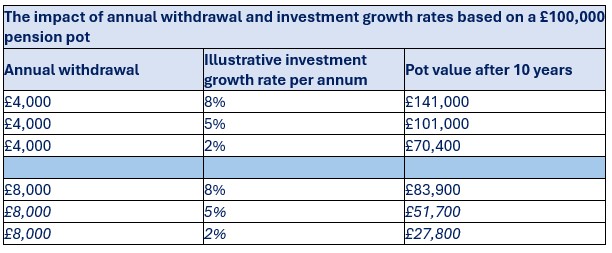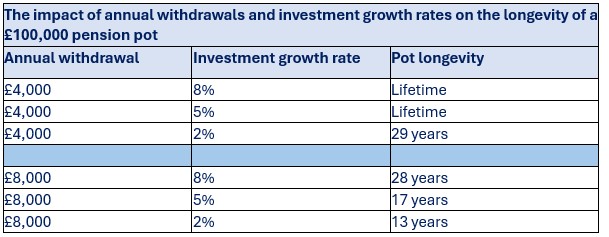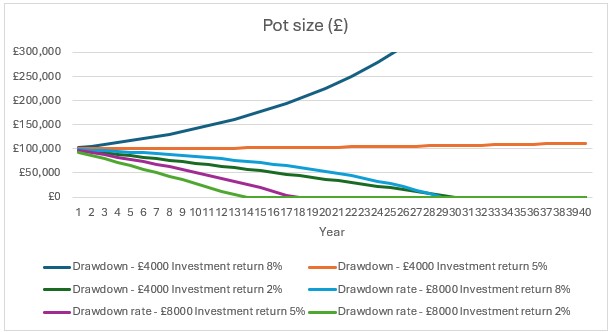A pension pot of £100,000 could last anything from a lifetime to just 13 years, depending on how much income an individual takes and the level of investment returns they experience, according to Standard Life. The new analysis highlights the challenges of navigating retirement given the uncertainty people face when planning for a combination of living costs, investment returns and longevity.
The method – two withdrawal amounts and three investment return scenarios
The analysis examined two withdrawal scenarios based on a pension pot of £100,000 and applied a fixed withdrawal of £4,000 and a higher one at £8,000 per year. These are equivalent to 4% and 8% of the initial pot respectively and are commonly used according to the FCA retirement income data for 2023-241. The analysis then assessed the impact of different investment returns on the pension pot after ten years, ranging from a return of 8%, 5% and 2%.

*Figures rounded down to 3 significant figures. Figures assume annual management charge of 0.75% and are not adjusted to account for inflation
Outcomes after ten years after withdrawing £4,000 per annum
After ten years those who withdrew £4,000 of their pension each year would have a pot worth between £141,000 if they secured 8% returns and just £70,400 with 2% returns. This works out at a difference of £70,600 highlighting the crucial role of returns on people’s retirement incomes.
Outcomes after ten years after withdrawing £8,000 per annum
For those who withdrew £8,000 each year, their pot would be worth between £83,900 if they secured 8% returns and just £27,800 with 2% returns. The impact of the additional withdrawals is particularly stark when compared to the lower withdrawal outcomes.
How long could the pot last? The self-sustaining pot versus a 13-year pot
The analysis looked forward to assess how long the pension pots would last in each of the different scenarios. Those who took £4,000 each year would not exhaust their pot if it grew by either 5% or 8%, as the investment returns would offset those withdrawals. In the 2% growth scenario their pension would still last 29 years. In the higher withdrawal scenario, however, each of the pots would eventually run out, with the high return scenario lasting 28 years compared to just 13 years in the low return equivalent.

*Figures assume annual management charge of 0.75% and do not account for inflation
The impact of different annual withdrawals and investment growth rates on the longevity of a £100,000 pension pot:

While these figures are illustrative, the FCA’s retirement income data shows that over 225,000 individuals made withdrawals at 8% or above. The figures also show that more than 50,000 individuals with pension pots between £50,000 and £99,000 made regular withdrawals of 8% or more in 2023 / 2024. A further 40,000 individuals with pots between £100,000 and £249,000 were also drawing down at this level, highlighting the potential risk of outliving their savings.
Pete Cowell, Head of Annuities at Standard Life said: “Pension freedoms gave retirees greater choice and flexibility, but with that freedom came responsibility and considerable financial planning challenges to weigh up. While those who accessed their pots for the first time in 2015 may now be taking stock of what remains, many current retirees are also likely to have the safety net of a DB pension to fall back on. However, with DB pensions in decline, and more people approaching retirement with larger, defined contribution pensions, monitoring the balance between withdrawals and investment returns has never been more critical to avoid outliving a pension. Through these illustrative scenarios, the investment returns are predictable each year, but the reality is that people will experience investment ups and downs while in drawdown which makes predicting how much your pot will be worth all the more difficult. Inflation will also be a key consideration, as people will need to manage this risk over the long-term to ensure their purchasing power isn’t eroded.
“There are options for those who want to mitigate investment and longevity risk. Many people are opting to cover their essential living costs with a guaranteed income through a combination of the state pension and an annuity. This approach removes many of the unknowns as you know your core living costs will be met while also providing the potential for investment growth on any pension placed in drawdown. With the Pension Scheme Bill expected to legislate for default retirement income solutions we expect to see approaches that blend a combination of income certainty and flexibility become more and more mainstream.”
|

